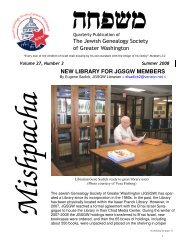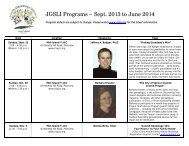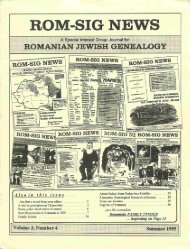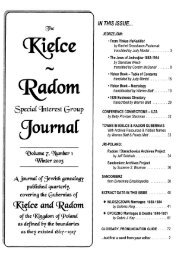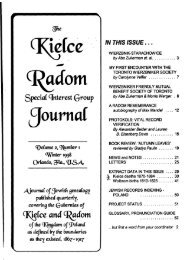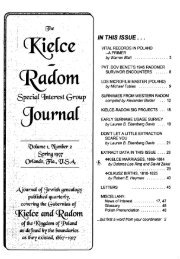THE MEMORIAL BOOK OF PÁPA JEWRY - JewishGen
THE MEMORIAL BOOK OF PÁPA JEWRY - JewishGen
THE MEMORIAL BOOK OF PÁPA JEWRY - JewishGen
Create successful ePaper yourself
Turn your PDF publications into a flip-book with our unique Google optimized e-Paper software.
YESHIVAS<br />
Rabbis considered it their sacred duty to educate young people, preparing them in the<br />
yeshivas for a strictly religious way of living, teaching them to be pious and well-versed also in<br />
the devotional studies. R. Wolf Rapaport, elected in 1781, organized a large yeshiva in Pápa,<br />
which turned out outstanding rabbis. Even Lipót Lőw, the great reform-age rabbi had a yeshiva<br />
during his short time in Pápa. The father of Henrik Marcali, the great master of Hungarian<br />
historiography, was one of his students, and later became the rabbi of Marcali. Mór Ballagi, at the<br />
time Móric Bloch, also attended the Pápa yeshiva, later becoming a member of the Hungarian<br />
Academy of Sciences.<br />
This blessed teaching job of religious education was continued by subsequent leading<br />
rabbis Salamon Breuer and M. A. RóthWhen the latter made a stand supporting Zionism, the<br />
Ortodox rabbis of the periodfrightened his students away from him, so during his lifetime the<br />
yeshiva of Pápa stopped functioning. There was a long interval when the rabbinical seat remained<br />
unoccupied and for decades there was no yeshiva in Pápa. Yeshiva life in Pápa was restarted only<br />
after the First World War. The yeshiva was reorganized by Ezriel Gestettner, the son-in law of<br />
Vilmos Steiner, a respectable community chairman at the time. He was helped by Reb. Avraham<br />
Dirnfeld. Both led the yeshiva with great zeal. When the former Tolcsva rabbi Samuel Gottlieb<br />
z"l became the chief rabbi of Pápa in 1927, organizing a yeshiva was one of the first things he<br />
did. Unfortunately, this Ashkenazi yeshiva ceased to exist after a period of barely two years,<br />
when Rabbi Gottlieb died.<br />
When Yechezkel Grünwald z"l, the former Bánfihunyad rabbi moved to Pápa in 1929, he<br />
immediately organized a chassidic yeshiva. In a short time, his yeshiva became so famous that<br />
the number of students grew to about 300. Strictly chassidic behaviour was required by the<br />
superiors, in addition to serious and profound learning. Many of the students continued their<br />
studies in Belz, and when they returned to their hometown, they wore chassidic attire. The long<br />
coats and beaver hats of the Pápa youngsters attracted great attention in the strictly Ashkenazi<br />
community. It is worth recording that when yeshiva students were drafted for forced labour<br />
service, Mihály Singer, a clothes dealer in Fő Utca (Main Street) provided for the needs of the<br />
destitute free of charge, despite the fact that he himself did not belong to the rabbi’s followers.<br />
The Holocaust destroyed the Pápa yeshiva as well. Only a handful of the pious students survived,<br />
most of who live in Brooklyn with their offspring, devotedly attending the so-called ‘Papa<br />
yeshiva’.<br />
39



